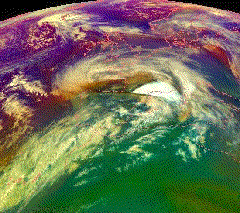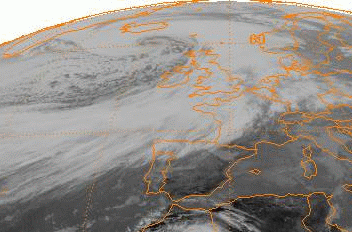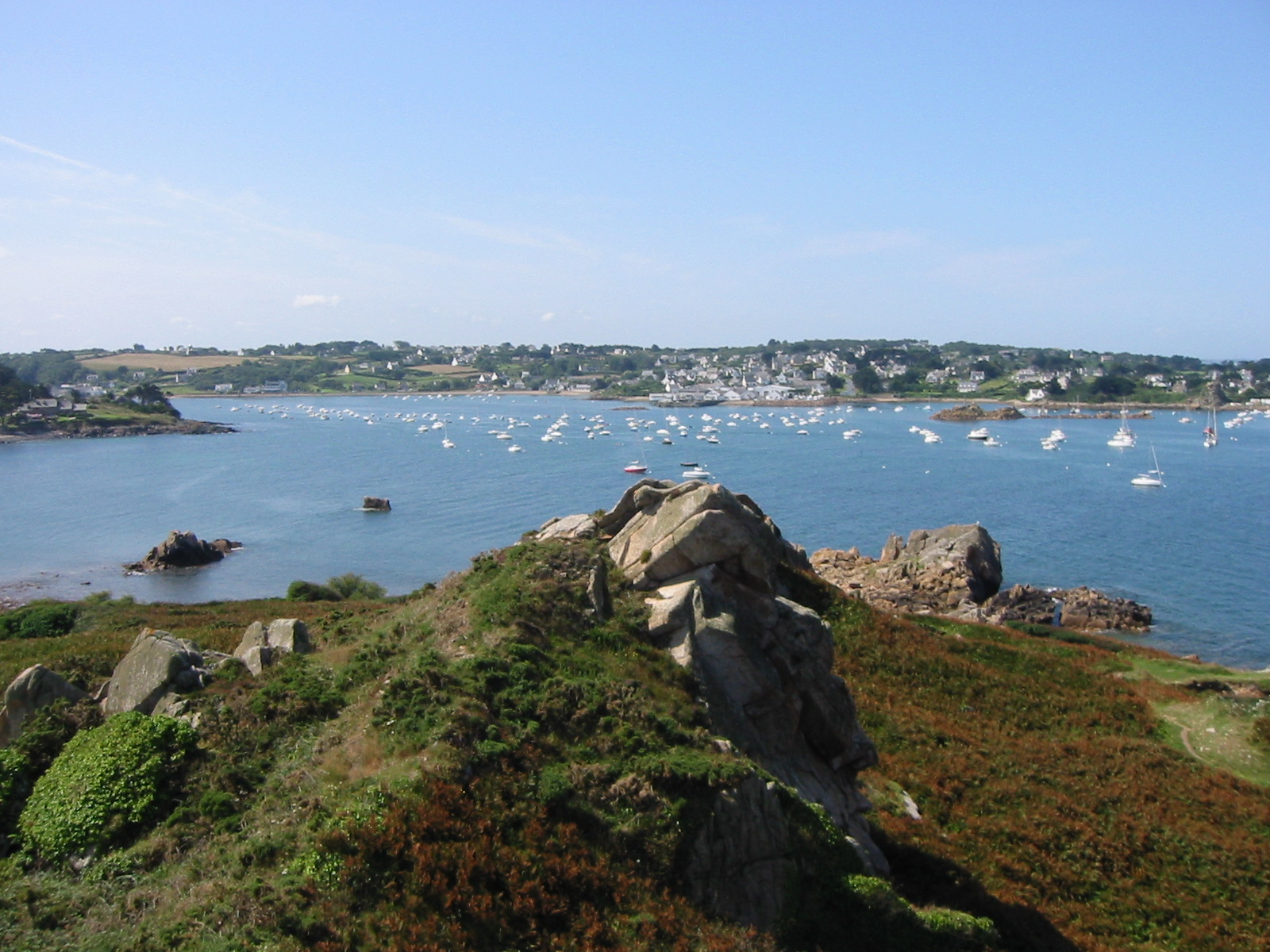|
Cyclone Joachim
Joachim is the name given to a European windstorm which caused major damage in much of Western Europe between December 16–17, 2011. Winds gusting to were recorded on the summit of Puy de Dôme in France. Joachim explosively deepened under the influence of a shortwave trough during its development. Impact At least 400,000 people were without power in France. In Brittany, on the north-western coast of France, the cargo ship ''TK Bremen'' was blown aground. The nineteen-man crew was evacuated by helicopter, and the ship later disassembled. Major damage occurred on the Spanish coast. Roofs and trees were blown away, and all navigation on the Swiss lakes was closed. In the canton of Bern, a tree fell onto the railway line between Tramelan and Tavannes. This caused a train to derail, and its forward cars fell into the forest; three passengers suffered minor injuries. The wind was followed by polar air, and the rain turning to snow at high altitudes and descending in ... [...More Info...] [...Related Items...] OR: [Wikipedia] [Google] [Baidu] |
European Windstorm
European windstorms are powerful extratropical cyclones which form as cyclonic windstorms associated with areas of low atmospheric pressure. They can occur throughout the year, but are most frequent between October and March, with peak intensity in the winter months. Deep areas of low pressure are common over the North Atlantic, and occasionally start as nor'easters off the New England coast. They frequently track across the North Atlantic Ocean towards the north of Scotland and into the Norwegian Sea, which generally minimizes the impact to inland areas; however, if the track is further south, it may cause adverse weather conditions across Central Europe, Northern Europe and especially Western Europe. The countries most commonly affected include the United Kingdom, Ireland, the Netherlands, Norway, Germany, the Faroe Islands and Iceland. The strong wind phenomena intrinsic to European windstorms, that give rise to "damage footprints" at the surface, can be placed into three cat ... [...More Info...] [...Related Items...] OR: [Wikipedia] [Google] [Baidu] |
Explosive Cyclogenesis
Explosive cyclogenesis (also referred to as a weather bomb, meteorological bomb, explosive development, bomb cyclone, or bombogenesis) is the rapid deepening of an Extratropical cyclone, extratropical cyclonic low-pressure area. The change in pressure needed to classify something as explosive cyclogenesis is latitude dependent. For example, at 60° latitude, explosive cyclogenesis occurs if the central pressure decreases by or more in 24 hours. This is a predominantly maritime, winter event, but also occurs in continental settings, This process is the extratropical equivalent of the tropical rapid deepening. Although their cyclogenesis is entirely different from that of tropical cyclones, bomb cyclones can produce winds of , the same order as the first categories of the Saffir–Simpson scale, and yield heavy precipitation. Even though only a minority of the bomb cyclones become so strong, some weaker ones have also caused significant damage. History In the 1940s and 1950s, mete ... [...More Info...] [...Related Items...] OR: [Wikipedia] [Google] [Baidu] |
2011 In France
The 2011 French presidential election was held on 22 April and 6 May 2011 and marked the end of Presidency of Nicolas Sarkozy, Nicolas Sarkozy's presidency. The Socialist Party candidate, François Hollande, defeated the incumbent President Sarkozy and became the first left-wing President of the Fifth Republic. The first round of voting saw a record turnout of 80.7%, with Sarkozy taking 27.2% of the vote and François Hollande, Hollande taking 28.6%. This marked the first time since 1965 that an incumbent president had failed to win the first round. The second round, held on 6 May, saw a significantly lower turnout of 79.5%, with Hollande taking 51.6% of the vote and Nicolas Sarkozy, Sarkozy taking 48.4%. Hollande's victory was widely seen as a sign of the French people's discontent with Presidency of Nicolas Sarkozy, Sarkozy's term in office. He had been criticized for his perceived pro-business and pro-rich policies, as well as his personal life, which was widely seen as too fl ... [...More Info...] [...Related Items...] OR: [Wikipedia] [Google] [Baidu] |
2011 In Switzerland
Events from 2011 in Switzerland. Events Public holidays in one or several cantons of Switzerland are marked (¹). January *January 1: New Year's Day¹ *January 2: Berchtoldstag¹ February March *March 19:Saint Joseph's Day *March 29:Good Friday *March 31:Easter Day April *April 1:Easter Monday May *May–June- 2011 Germany E. coli O104:H4 outbreak affected Switzerland *May 1:May Day *May 9:Ascension Day *May 19:Pentecost *May 20:Whit Monday *May 30:Corpus Christi June *June 16-Convention on Domestic Workers signed, took place in Geneva July *July 2- Some Swiss tourists were kidnapped in Balochistan *July 25-July 31- 2011 Crédit Agricole Suisse Open Gstaad was in play August *August-August 2011 stock markets fall affected the Swiss Franc *August 1:Swiss National Day *August 15:Assumption of Mary *August 17-August 21- 2011 Basel Summer Ice Hockey was in play September *September 16:Swiss federal fast October *October 31-November 6-2011 Swiss Indoors was in play November ... [...More Info...] [...Related Items...] OR: [Wikipedia] [Google] [Baidu] |
European Windstorms
European windstorms are powerful extratropical cyclones which form as cyclonic windstorms associated with areas of low atmospheric pressure. They can occur throughout the year, but are most frequent between October and March, with peak intensity in the winter months. Deep areas of low pressure are common over the North Atlantic, and occasionally start as nor'easters off the New England coast. They frequently track across the North Atlantic Ocean towards the north of Scotland and into the Norwegian Sea, which generally minimizes the impact to inland areas; however, if the track is further south, it may cause adverse weather conditions across Central Europe, Northern Europe and especially Western Europe. The countries most commonly affected include the United Kingdom, Ireland, the Netherlands, Norway, Germany, the Faroe Islands and Iceland. The strong wind phenomena intrinsic to European windstorms, that give rise to "damage footprints" at the surface, can be placed into three cat ... [...More Info...] [...Related Items...] OR: [Wikipedia] [Google] [Baidu] |
Valais
Valais ( , , ; frp, Valês; german: Wallis ), more formally the Canton of Valais,; german: Kanton Wallis; in other official Swiss languages outside Valais: it, (Canton) Vallese ; rm, (Chantun) Vallais. is one of the cantons of Switzerland, 26 cantons forming the Switzerland, Swiss Confederation. It is composed of thirteen districts and its capital and largest city is Sion, Switzerland, Sion. The flag of the canton is made of thirteen stars representing the districts, on a white-red background. Valais is situated in the southwestern part of Switzerland, the country. It borders the cantons of Canton of Vaud, Vaud and Canton of Bern, Bern to the north, the cantons of Canton of Uri, Uri and Ticino to the east, as well as Italy to the south and France to the west. It is one of the three large southern Alps, Alpine cantons, along with Ticino and the Grisons, which encompass a vast diversity of ecosystems. It is a bilingual canton, French language, French and German language, German ... [...More Info...] [...Related Items...] OR: [Wikipedia] [Google] [Baidu] |
Tavannes
Tavannes is a municipality in the Jura bernois administrative district in the canton of Bern in Switzerland. It is located in the French-speaking part of the canton in the Jura mountains. History The area around Tavannes was traversed by the early inhabitants of the Helvetic plain because of the natural tunnel through the Jura between the valley of the Suze and the valley of the Birse. Under the Emperor Marcus Aurelius, the Romans improved this road between 161 and 169 AD. The Roman administrator left an inscription in the cliff at Pierre-Pertuis to this effect. Early mills were built along the Birse, utilizing its water as a source of power. Tavannes was one of the earliest inhabited locations in the district. Its name comes from the ancient Germanic words 'Þahs-winja, ancien haut allemand dahs, germanique *þahsu, « blaireau », et gothique vinja, germanique *venjô, « pâturage » errenot ',which means the same as the older German name 'Dachsfelden'. In the fourth cen ... [...More Info...] [...Related Items...] OR: [Wikipedia] [Google] [Baidu] |
Tramelan
Tramelan is a municipality in the Jura bernois administrative district in the canton of Bern in Switzerland. It is located in the French-speaking Bernese Jura (''Jura Bernois''). History Tramelan is first mentioned in 1179 as ''Trameleins''. The municipality was formerly known by its German name ''Tremlingen'', however, that name is no longer used. During the Middle Ages the collegiate church of Saint-Imier was the major landholder in Tramelan. Politically, the villages were part of the seigniory of Erguel under the Prince-Bishop of Basel. From the 13th century until the mid 15th century there was a local noble family that ruled in Tramelan, probably as a fief under the Prince-Bishop. The village of Tramelan-le-Bas was first mentioned in 1334 while Tramelan-le-Haut appears in documents in 1358. In 1481, 1543 and 1581 the two villages met together to officially define their mutual border. In 1686, immigrants from Neuchâtel established the village of Mont-Tramelan. Af ... [...More Info...] [...Related Items...] OR: [Wikipedia] [Google] [Baidu] |
Canton Of Bern
The canton of Bern or Berne (german: Kanton Bern; rm, Chantun Berna; french: canton de Berne; it, Canton Berna) is one of the 26 cantons forming the Swiss Confederation. Its capital city, Bern, is also the ''de facto'' capital of Switzerland. The bear is the heraldic symbol of the canton, displayed on a red-yellow background. Comprising ten districts, Bern is the second-largest canton by both surface area and population. Located in west-central Switzerland, it is surrounded by eleven cantons. It borders the canton of Jura and the canton of Solothurn to the north. To the west lie the canton of Neuchâtel, the canton of Fribourg and canton of Vaud. To the south lies the canton of Valais. East of the canton of Bern lie the cantons of Uri, Nidwalden, Obwalden, Lucerne and Aargau. The geography of the canton includes a large share of all three natural regions of Switzerland: the Jura Mountains (the Bernese Jura), the Swiss Plateau (the Bernese Mittelland) and the Alps (th ... [...More Info...] [...Related Items...] OR: [Wikipedia] [Google] [Baidu] |
Brittany (administrative Region)
Brittany (french: Bretagne ; br, Breizh ); Gallo: ''Bertaèyn'' ) is the westernmost region of Metropolitan France. It covers about four fifths of the territory of the historic province of Brittany. Its capital is Rennes. It is one of the two Regions in Metropolitan France that does not contain any landlocked departments, the other being Corsica. Brittany is a peninsular region bordered by the English Channel to the north and the Bay of Biscay to the south, and its neighboring regions are Normandy to the northeast and Pays de la Loire to the southeast. " Bro Gozh ma Zadoù" is the anthem of Brittany. It is sung to the same tune as that of the national anthem of Wales, "Hen Wlad Fy Nhadau", and has similar words. As a region of France, Brittany has a Regional Council, which was most recently elected in 2021. Territory The region of Brittany was created in 1941 from four of the five departments constituting the territory of traditional Brittany. The other is Loire-A ... [...More Info...] [...Related Items...] OR: [Wikipedia] [Google] [Baidu] |
Puy De Dôme
Puy de Dôme (, ; oc, label=Auvergnat, Puèi Domat or ) is a lava dome and one of the youngest volcanoes in the region of Massif Central in central France. This chain of volcanoes including numerous cinder cones, lava domes and maars is far from the edge of any tectonic plate. Puy de Dôme was created by a Peléan eruption, some 10,700 years ago. Puy de Dôme is approximately from Clermont-Ferrand. The Puy-de-Dôme is named after the volcano. History In pre-Christian Europe, Puy de Dôme served as an assembly place for spiritual ceremonies. Temples were built at the summit, including a Gallo-Roman temple of Mercury, the ruins of which were discovered in 1873. In 1648, Florin Périer, at the urging of Blaise Pascal, supported Evangelista Torricelli's theory that barometric observations were caused by the weight of air by measuring the height of a column of mercury at three elevations on Puy de Dôme. In 1875, a physics laboratory was built at the summit. Since 1956, ... [...More Info...] [...Related Items...] OR: [Wikipedia] [Google] [Baidu] |









